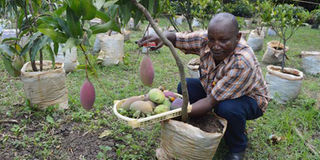Portable orchard for the smart urban farmer

Samuel Manene harvests produce from his movable orchard in Kasarani. Mr Manene grows oranges, mangoes and apples in polythene bags in a technique that sees him harvest big from his quarter-acre PHOTO | ERIC WAINAINA | NATION MEDIA GROUP
What you need to know:
- Manure and fertiliser are important as they ensure the roots do not grow out of the bags.
- A farmer adopting the practice needs to know the exact amount of manure or fertiliser to apply and in what duration.
The cypress trees surrounding the quarter-acre farm in Kasarani, Nairobi, sway from left to right as the wind blows.
Swaying together with the trees, albeit slightly, are mango, tree tomato, apple and orange fruit trees grown inside polythene bags.
Samuel Manene is the owner of what he calls the ‘mobile orchard’.
“This is my orchard and it gives me more than I need. I harvest mangoes, oranges, apples and tree tomatoes as from any other farm,” says Manene, a prison officer who holds a degree in crop protection from the University of Nairobi and recently completed a second degree in horticulture from Jomo Kenyatta University of Agriculture and Technology.
The practice, according to him, suits urban dwellers, who have rented houses and have limited space.
“With a portable orchard, you enjoy not only the fruits, but you can move with the garden if you are shifting base,” he offers.
According to Manene who is the Kiambu GK Prison farm manager, the movable orchard works well with mangoes, oranges, tree tomatoes, strawberries, paw paws and apples.
Sergeant Manene, who also came up with the pomato crop (a plant grafted from tomato and potato), says making a mobile orchard mainly involves grafting a seedling with a bud from a mature tree to ensure the plant starts bearing fruits within a short period.
But before the grafting, one should prepare the soil. This involves getting loam soil, which is then mixed with animal and compost manure or fertiliser to ensure it has adequate nutrients.

Samuel Manene harvests produce from his movable orchard in Kasarani. PHOTO | ERIC WAINAINA | NATION MEDIA GROUP
The soil is then put in plastic cans or polythene bags measuring one-and-a-half feet squared that help maintain moisture. One makes two holes on the side of the bag to avoid water-logging.
Water is of essence, and according to Manene, the crops should be supplied with plenty of it, most preferably using drip irrigation technique.
Manure and fertiliser are also important as they ensure the roots do not grow to penetrate out of the bags or break the containers. Soil, organic manure and pebbles are mixed in a ratio of 4:2:1 before being stuffed in the plastic bag.
“Roots grow longer because the plant wants to reach where nutrients and water are. But if you ensure that there is a constant supply of them in the bags, the roots will not grow that long,” Manene says, noting that his goal is to ensure that more people in urban areas grow fruits.
MOVE THEM WHEN RELOCATING
With the plants being in portable containers, the owner enjoys the benefits of getting fresh fruits, and can also move them when they are relocating without destroying the plants.
A farmer controls the height of the plant through pruning, and if well taken care of, Manene says a mango or orange tree can last for a life time and yield up to 1,000 fruits annually.
“The plants grow to between 5 and 7 feet. But you only realise this if you supply adequate manure, fertiliser and water. If the polythene bags and the plastic containers wear out, you can always change and still maintain the plant,” he says, adding that it takes about one-and-a half years for the plant to start bearing fruits.
He sells his fruits that include oranges, mangoes and apples at Sh30 each to consumers while wholesalers, including the Afya juice making company, buy at Sh20 each.

Samuel Manene harvests fruits in his movable orchard in Kasarani. With the plants in portable containers, the owner enjoys the benefits of getting fresh fruits, and also ability to move them when they are relocating, without destroying the plants. PHOTO | ERIC WAINAINA | NATION MEDIA GROUP
Joseph Mureithi, the principal of Waruhiu Agricultural Development Centre in Githunguri, Kiambu County, says:
“A farmer adopting the practice needs to know the exact amount of manure or fertiliser to apply and in what duration. He also needs to closely manage the plant itself.”
Knowing the exact amount of foliar fertiliser or manure to use can help one dictate how the fruit grows, including when to flower.
Apart from enjoying the fruits, one can also practice mixed cropping by planting vegetables such as tomatoes, sukuma wiki and spinach inside the bags carrying the fruits.
“The only problem with the technology is that you cannot do it on large-scale, then there is a lot of knowledge gap where farmers may not know how to control the height of the plant and manipulate its growth.”
More research needs to be done on the technique to boost it, he adds.





